6.02 Structure of DNA and RNA
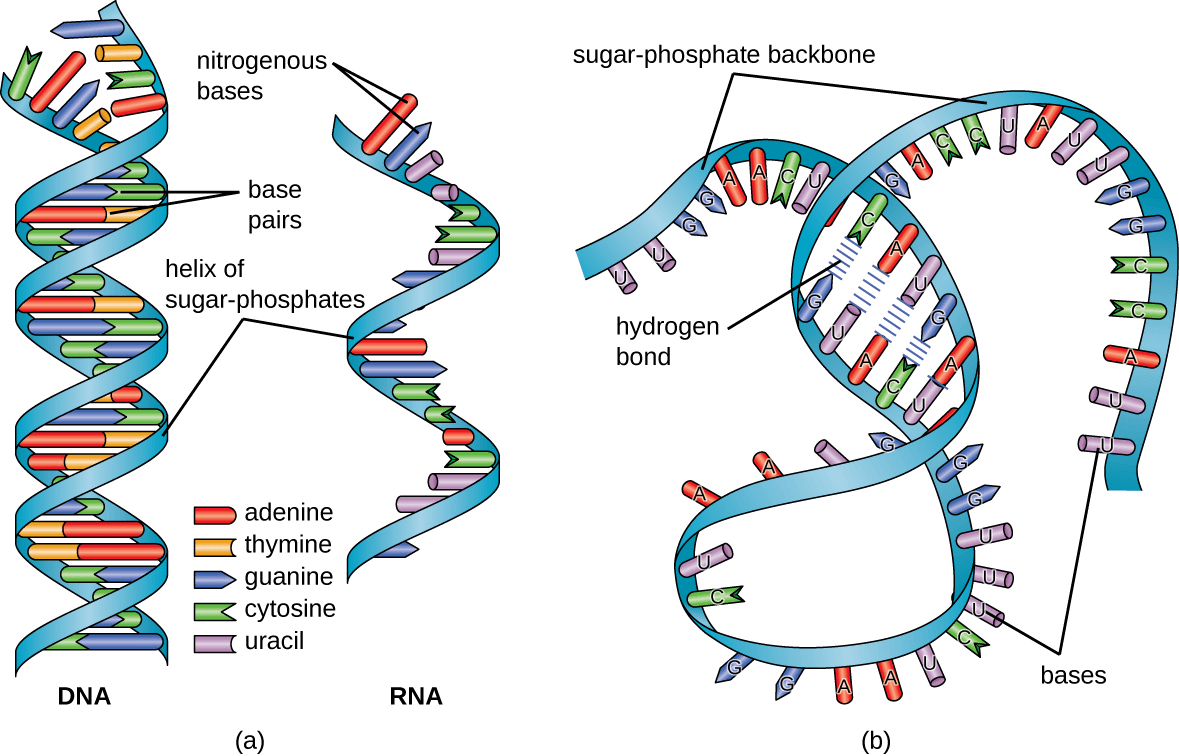
Overview: DNA and RNA
- DNA: Deoxyribonucleic Acid
- RNA: Ribonucleic Acid
- Both DNA and RNA are polynucleotides (long chains of nucleotides).
- Nucleic Acids: Named because they were first identified in cell nuclei.
- Polymers: Composed of repeating units called nucleotides.
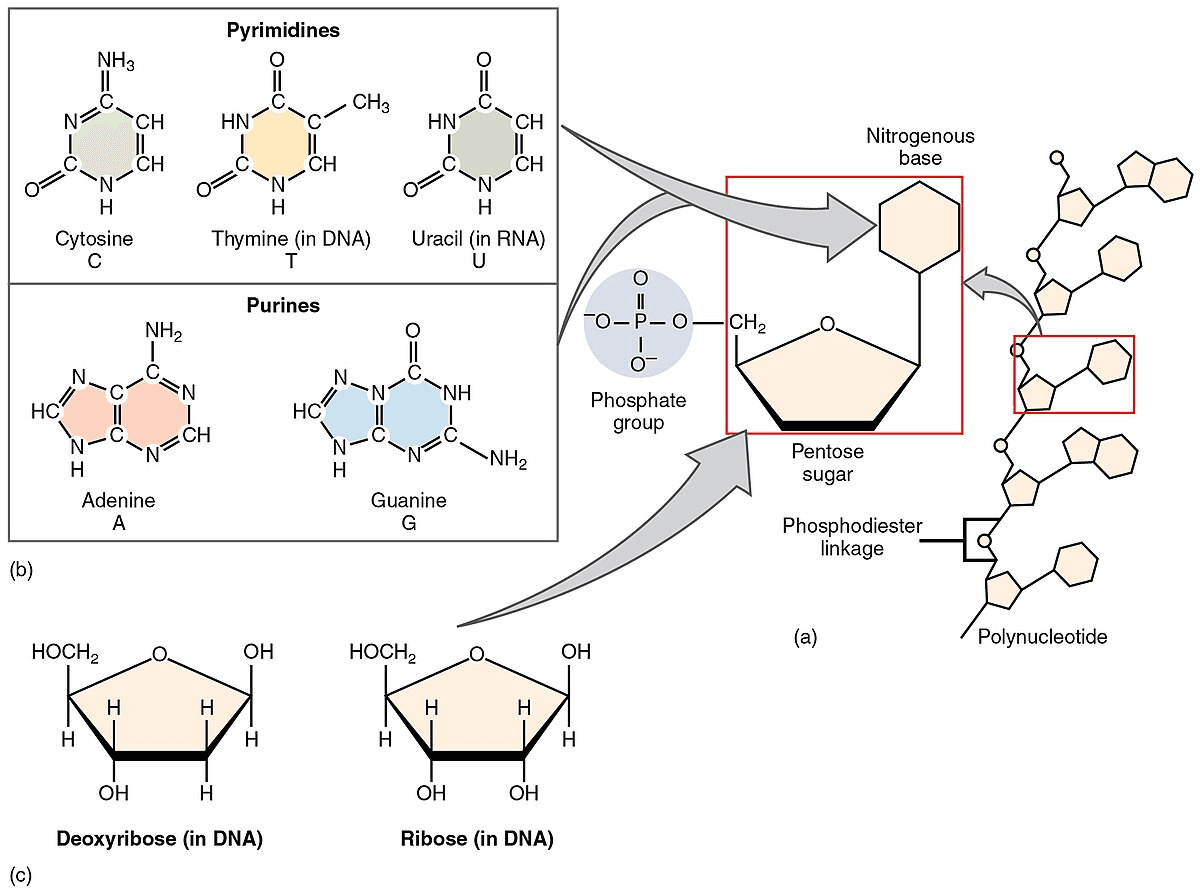
Structure of Nucleotides
- Components of a Nucleotide:
- Nitrogen-containing Base: Four types in DNA (Adenine, Guanine, Cytosine, Thymine); RNA has Uracil instead of Thymine.
- Purines: Adenine (A) and Guanine (G) (two-ring structures).
- Pyrimidines: Cytosine (C), Thymine (T), and Uracil (U) (one-ring structures).
- Nitrogen-containing Base: Four types in DNA (Adenine, Guanine, Cytosine, Thymine); RNA has Uracil instead of Thymine.
- Pentose Sugar:
- DNA: Deoxyribose (missing one oxygen atom).
- RNA: Ribose.
- Phosphate Group: Contributes the acidic nature of nucleic acids.
- Polynucleotides:
- Nucleotides are linked by phosphodiester bonds between the sugar of one nucleotide and the phosphate of the next.
- Forms a sugar-phosphate backbone with nitrogenous bases sticking out.
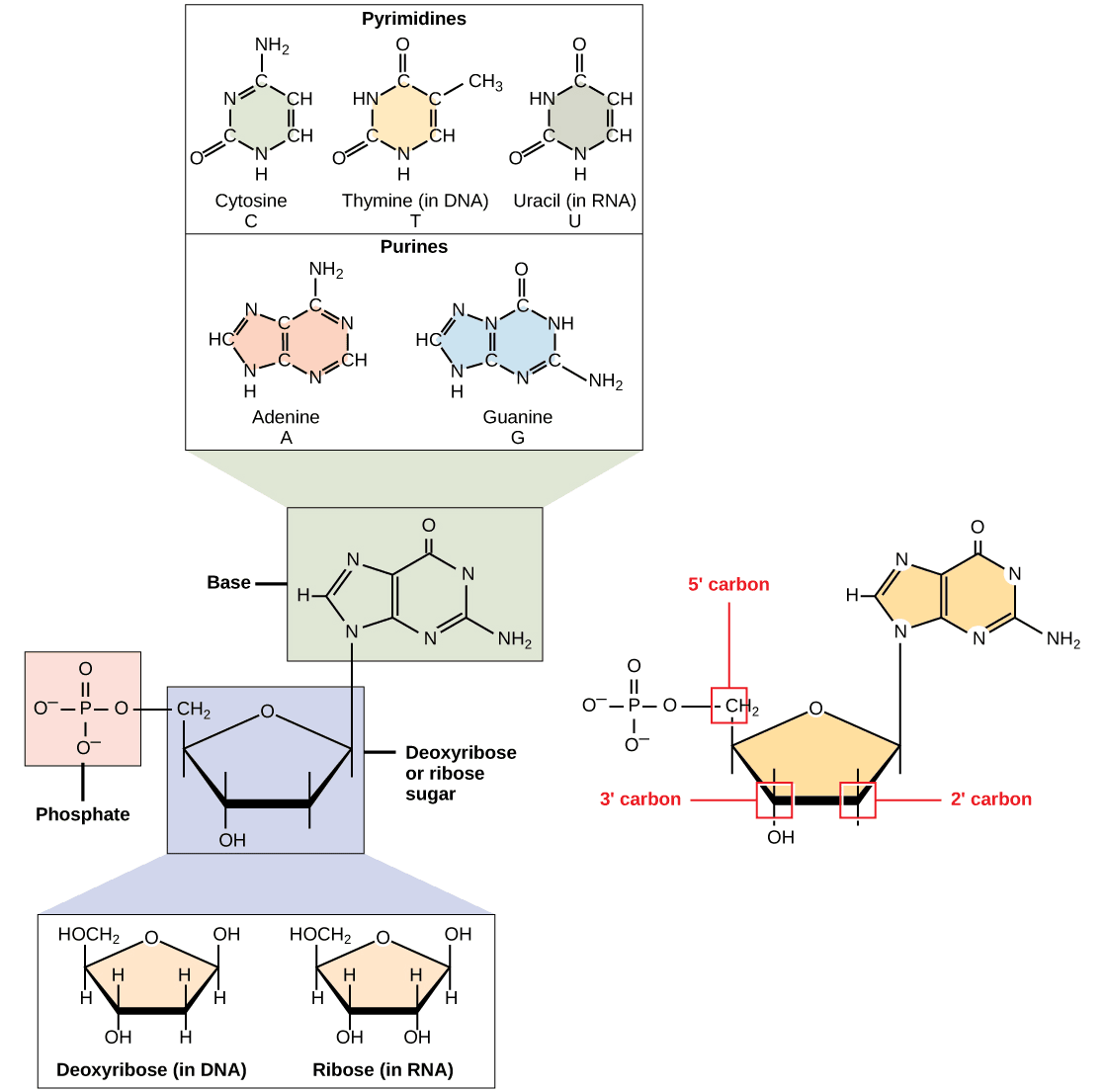
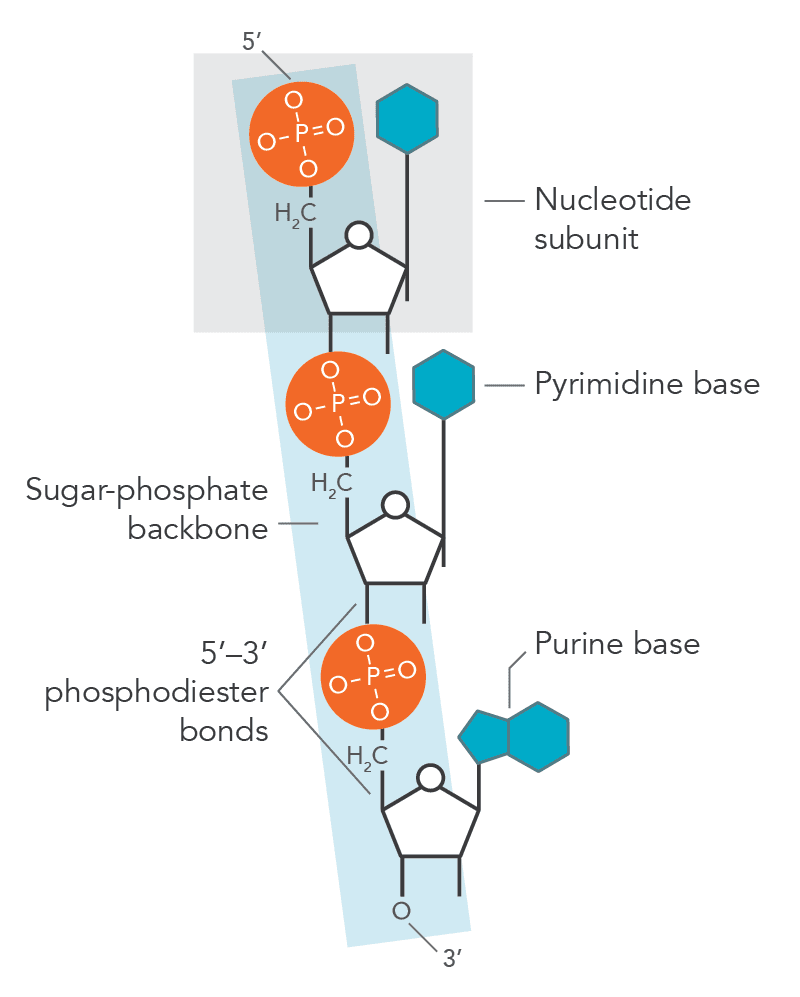
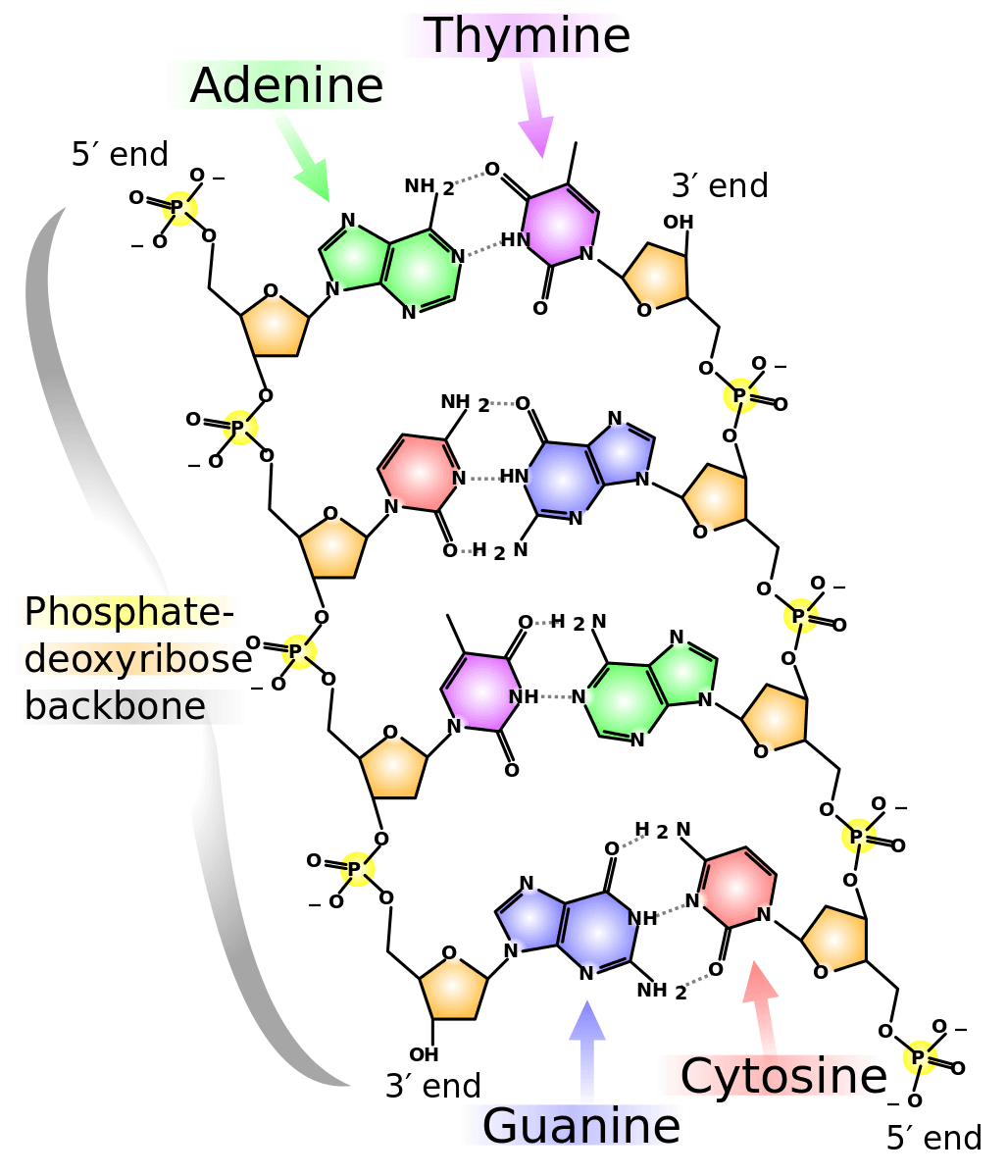
Formation of a Polynucleotide:
- Process:
- Condensation Reaction joins nucleotides.
- Covalent bond forms between:
- Phosphate group of one nucleotide.
- Sugar (3′ OH group) of the next nucleotide.
- Type of Bond:
- Phosphodiester bond:
- Links 5′ phosphate of one nucleotide to the 3′ hydroxyl of the next.
- Phosphodiester bond:

Key Points:
- By-product: Water (H₂O) is released.
- Directionality:
- Chain grows in the 5′ to 3′ direction (important for DNA/RNA synthesis).
- Result:
- Formation of a sugar-phosphate backbone.
- Nitrogenous bases extend from the backbone.


Formation of a Polynucleotide:
- Bases project outward for base pairing (in DNA/RNA).
- Condensation Reaction:
- 5′ Phosphate + 3′ OH → Phosphodiester Bond + H₂O.
- Repeating Units:
- Backbone: Sugar–Phosphate–Sugar–Phosphate.
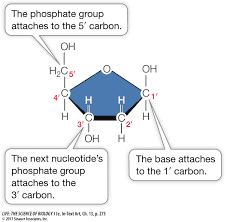

Structure of DNA
- Double Helix Model (Watson and Crick, 1953):
- Two Polypeptide Chains: Form a right-handed double helix.
- Antiparallel Strands: Chains run in opposite directions (5′ to 3′ and 3′ to 5′).
- Complementary Base Pairing:
- Adenine (A) pairs with Thymine (T) via two hydrogen bonds.
- Guanine (G) pairs with Cytosine (C) via three hydrogen bonds.
- Purines always pair with pyrimidines, maintaining a consistent width (three rings) between backbones.
- Helix Characteristics:
- One complete turn of the helix contains 10 base pairs.
- Sugar-phosphate backbones form the outer framework, with bases projecting inwards at right angles.
- Importance of Structure:
- Storage of Information: Sequence of bases along one strand serves as a genetic code.
- Replication: DNA can “unzip” along hydrogen bonds, allowing each strand to serve as a template for a new complementary strand, ensuring accurate copying.


Structure of RNA
- Single-Stranded Molecule:
- RNA consists of a single polynucleotide chain.
- Three types of RNA involved in protein synthesis:
- mRNA (Messenger RNA): Carries genetic code from DNA to ribosomes.
- tRNA (Transfer RNA): Transports amino acids to ribosomes during protein synthesis.
- rRNA (Ribosomal RNA): Structural component of ribosomes.

Practise Questions 1
Questions and Answers
1. Describe the structure of a nucleotide.
- Answer: A nucleotide consists of a nitrogenous base (adenine, thymine, cytosine, guanine, or uracil in RNA), a pentose sugar (deoxyribose in DNA, ribose in RNA), and a phosphate group.
2. How are nucleotides linked together in DNA and RNA?
- Answer: Nucleotides are joined by phosphodiester bonds between the phosphate group of one nucleotide and the pentose sugar of the next, forming a sugar-phosphate backbone.
3. What are the structural differences between DNA and RNA?
- Answer:
- DNA is double-stranded and contains deoxyribose; RNA is single-stranded and contains ribose.
- DNA has thymine as a base, while RNA has uracil in place of thymine.
4. Explain complementary base pairing in DNA.
- Answer: In DNA, adenine pairs with thymine via two hydrogen bonds, and guanine pairs with cytosine via three hydrogen bonds. This pairing maintains a uniform width of the double helix and allows for accurate replication.
5. How does the structure of DNA facilitate its role in heredity?
- Answer: DNA’s double helix structure with complementary base pairing allows it to store genetic information in the base sequence and replicate accurately by using each strand as a template for new complementary strands.
6. What are the types of RNA and their roles in protein synthesis?
- Answer:
- mRNA: Carries genetic information from DNA to ribosomes.
- tRNA: Delivers amino acids to the ribosome based on mRNA’s instructions.
- rRNA: Combines with proteins to form ribosomes, the site of protein synthesis.
7. What is the significance of Watson and Crick’s discovery of the DNA double helix?
- Answer: Their model explained how DNA stores genetic information in the base sequence and how it replicates through the unzipping and pairing of complementary strands, essential for inheritance and cell function.
Practise Questions 2
Question 1
Describe the structure of a nucleotide and explain how nucleotides form polynucleotides. (6 marks)
Mark Scheme:
- A nucleotide consists of a nitrogen-containing base, a pentose sugar, and a phosphate group. (1 mark)
- In DNA, the sugar is deoxyribose, while in RNA, it is ribose. (1 mark)
- Nitrogenous bases are divided into purines (adenine and guanine) and pyrimidines (cytosine, thymine, and uracil). (1 mark)
- Nucleotides are joined by phosphodiester bonds between the phosphate group of one nucleotide and the sugar of the next. (1 mark)
- This forms a sugar-phosphate backbone, with nitrogenous bases projecting outward. (1 mark)
- The bond forms via a condensation reaction, releasing water as a by-product. (1 mark)
Question 2
Explain the structure of DNA and how its features enable its function. (6 marks)
Mark Scheme:
- DNA consists of two polynucleotide chains arranged in a right-handed double helix. (1 mark)
- The two strands are antiparallel, running in opposite directions (5′ to 3′ and 3′ to 5′). (1 mark)
- Complementary base pairing occurs: adenine pairs with thymine (two hydrogen bonds), and guanine pairs with cytosine (three hydrogen bonds). (1 mark)
- The consistent pairing of purines with pyrimidines maintains a uniform width of the helix. (1 mark)
- DNA’s structure allows information storage in the sequence of bases and replication by unzipping the strands along hydrogen bonds. (1 mark)
- The sugar-phosphate backbone provides stability, while the bases project inward for protection. (1 mark)
Question 3
Compare the structures of DNA and RNA. (5 marks)
Mark Scheme:
- DNA is a double-stranded helix, while RNA is a single-stranded molecule. (1 mark)
- DNA contains deoxyribose, whereas RNA contains ribose. (1 mark)
- In DNA, the base thymine pairs with adenine, but in RNA, uracil replaces thymine. (1 mark)
- DNA is primarily involved in genetic information storage, while RNA functions in protein synthesis (mRNA, tRNA, rRNA). (1 mark)
- DNA is stable and found in the nucleus, while RNA is more unstable and operates in both the nucleus and cytoplasm. (1 mark)
Question 4
Explain the process of complementary base pairing and its importance in DNA structure and function. (5 marks)
Mark Scheme:
- Complementary base pairing ensures adenine (A) pairs with thymine (T) via two hydrogen bonds, and guanine (G) pairs with cytosine (C) via three hydrogen bonds. (1 mark)
- This pairing maintains a consistent three-ring structure between the sugar-phosphate backbones. (1 mark)
- Complementary pairing allows DNA to store genetic information in the sequence of bases. (1 mark)
- During replication, the strands unzip along the hydrogen bonds, and each strand acts as a template for a new complementary strand. (1 mark)
- This ensures accuracy in DNA replication and the faithful transfer of genetic information. (1 mark)
Question 5
Describe how a polynucleotide chain is formed, emphasizing the role of phosphodiester bonds. (4 marks)
Mark Scheme:
- Nucleotides are joined via condensation reactions between the phosphate group of one nucleotide and the sugar of the next. (1 mark)
- A phosphodiester bond forms, linking the 5′ phosphate of one nucleotide to the 3′ hydroxyl group of the adjacent nucleotide. (1 mark)
- This creates a sugar-phosphate backbone, with nitrogenous bases extending outward. (1 mark)
- The chain grows in the 5′ to 3′ direction, which is critical for DNA and RNA synthesis. (1 mark)
Question 6
What are the differences between purines and pyrimidines, and how do they contribute to DNA structure? (4 marks)
Mark Scheme:
- Purines (adenine and guanine) are double-ring structures, while pyrimidines (cytosine, thymine, and uracil) are single-ring structures. (1 mark)
- In DNA, purines pair with pyrimidines (A-T, G-C) to maintain a consistent helix width. (1 mark)
- This pairing is stabilized by hydrogen bonds: two bonds between A and T, and three bonds between G and C. (1 mark)
- The alternating pairing ensures stability and uniformity in the DNA double helix. (1 mark)
Question 7
What are the three main types of RNA, and what are their roles in protein synthesis? (5 marks)
Mark Scheme:
- mRNA (Messenger RNA): Carries the genetic code from DNA in the nucleus to the ribosome in the cytoplasm. (1 mark)
- tRNA (Transfer RNA): Transports specific amino acids to the ribosome for incorporation into the polypeptide chain. (1 mark)
- rRNA (Ribosomal RNA): Forms the structural and functional components of ribosomes, facilitating translation. (1 mark)
- Each RNA type plays a distinct role in ensuring accurate translation of genetic information into proteins. (1 mark)
- RNA’s single-stranded structure allows it to fold into specific shapes necessary for its functions. (1 mark)
Question 8
Why is the 5′ to 3′ directionality important in polynucleotide chains? (4 marks)
Mark Scheme:
- Polynucleotide chains grow by adding nucleotides to the 3′ hydroxyl group. (1 mark)
- DNA and RNA synthesis occurs in the 5′ to 3′ direction, ensuring the correct sequence alignment. (1 mark)
- Enzymes like DNA polymerase and RNA polymerase can only add nucleotides in this direction. (1 mark)
- Directionality is critical for the accurate replication and transcription of genetic material. (1 mark)
Question 9
What are the differences between mRNA, tRNA, and rRNA in structure and function? (6 marks)
Mark Scheme:
- mRNA: Linear single-stranded molecule carrying genetic code from DNA to ribosomes. (1 mark)
- tRNA: Cloverleaf-shaped molecule with an anticodon for codon recognition and an attachment site for amino acids. (1 mark)
- rRNA: Folded into complex structures that form ribosomes, providing sites for mRNA translation. (1 mark)
- Function:
- mRNA specifies the sequence of amino acids in a protein. (1 mark)
- tRNA delivers the correct amino acids to the ribosome. (1 mark)
- rRNA catalyzes peptide bond formation and ensures proper alignment of mRNA and tRNA. (1 mark)
Question 10
Explain the significance of complementary base pairing in DNA replication and RNA transcription. (6 marks)
Mark Scheme:
- Complementary base pairing ensures that adenine pairs with thymine (or uracil in RNA) and guanine pairs with cytosine. (1 mark)
- In DNA replication, the strands separate, and each serves as a template for a new complementary strand. (1 mark)
- This mechanism ensures accuracy in copying genetic material. (1 mark)
- In RNA transcription, complementary base pairing between DNA and RNA ensures the correct genetic code is transcribed. (1 mark)
- Example: DNA strand 3′-ATGC-5′ transcribes to RNA 5′-UACG-3′. (1 mark)
- This process preserves the integrity of genetic information for protein synthesis. (1 mark)
Quizzes
Test 1
Test 2
Test 3